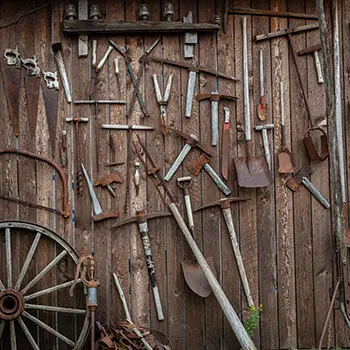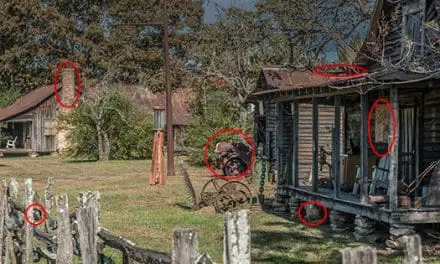There are many potential scenarios we could face these days that could disrupt our way of life. One of the most concerning is losing access to our power grid. Whether it’s due to cyberattacks, an EMP, or something else, a complete power outage is a frightening thought in today’s world. However, Amish homesteading lessons offer valuable insights into how to live independently and thrive without relying on modern power sources.
Experts have estimated that a year without power could lead to a 90% mortality rate in modern populations. The truth is, that most people today have no idea how to live without electricity. The loss of heat, air conditioning, lighting, and cooking appliances would make survival much more difficult.
However, there’s one group in modern society that has chosen to live without electricity—the Amish. For centuries, they’ve preserved food, lit their homes, worked the land, and cooked their meals without relying on power.
They use human labor, hand tools, wood stoves, and animal power to live comfortably. For those looking to thrive through long-term power outages, the Amish can teach us valuable lessons. In this article, we’ll explore the specific skills we can learn from their way of life.
Amish Homesteading Lessons on the Use of Non-Power Tools 
One thing you’ll quickly notice about the Amish is how well they care for their tools. I’ll admit, there have been times when I’ve left my tools out in the rain or didn’t put them back in the right place. You’ll never see that in an Amish community.
From a young age, they take pride in their tools and maintain them to a high standard. Their axes, awls, shovels, plows, anvils, and hammers are all kept in excellent condition.
In the Amish way of life, many animals serve as tools, with horses playing a crucial role in farming and transportation. The Amish take great care of these animals, ensuring they live long, healthy lives and perform at their best. Children learn early to saddle and train horses and harness them to plows and wagons.
In Amish communities, horses become part of the family and receive top-notch training, surpassing the care most horses get elsewhere.
One of the biggest challenges for modern homesteaders is the reliance on electricity and technology to run their daily operations. But what if suddenly there was no power? Here’s a complete list of Amish powerless tools for a world without power.
Homeschooling
If you spend any time in the Amish community, you’ll quickly see how much they value their children. Homeschooling is never easy, and it’s even more challenging in a community without the internet.
But the Amish have managed to keep their kids at least one grade level ahead of children their age in the modern world. They also successfully weave religion and farming techniques into their lessons. These children learn not only how to contribute to the farming needs of their community but also gain all the knowledge they need for the future. This dedication to education is one of the Amish homesteading lessons we can all learn from, showing how to balance tradition with essential skills.
Amish Homesteading Lessons in Hand Sewing 
Living without electricity means you’ll have to make and repair your own clothes. While many skilled seamstresses exist, few can do much without a sewing machine.
In Amish communities, however, children start learning to sew at a young age. This practice is one of the Amish homesteading lessons. It shows the importance of self-reliance. It also emphasizes passing down practical skills to the next generation.
By the time they’re a few years old, they spool thread, weave cloth, and design and sew their own clothes. They also mend any clothing worn out from hard work on the homestead. Their clothes are durable and built for tough work, with simple fasteners like buttons and Velcro commonly used.
Primitive Farming
Farming is the heart of Amish life, but they do it without the heavy farm equipment that most other homesteaders use. This approach is one of the Amish homesteading lessons, as they rely on horse-drawn tools to grow crops like corn, beans, wheat, hay, barley, potatoes, tomatoes, and grasses for grazing animals.
Much of what they grow is sold to neighboring communities to fund other projects. Crop rotation is key to Amish farming, ensuring the soil always has the nitrogen its crops need.
Related: Natural Remedies From The Amish
An interesting aspect of Amish life is that no one person handles everything alone. Instead, they specialize in different skills and work closely with others in their community. This way, they can quickly get fields worked or even raise a barn in a single day when necessary.
Food Storage and Food Preservation 
Some Amish homesteading lessons teach us the value of simple methods for cooking and food preservation. The Amish cook their meals using wood stoves, cast iron skillets, and open fires. They preserve food by canning, pickling, fermenting, and dehydrating, ensuring they have enough to last all year.
They also rely on root cellars to store veggies like potatoes and carrots in a cool, dark place. Additionally, they make homemade jams, jellies, and sauerkraut to keep their meals tasty and nutritious through the winter.
For storing food in small spaces, a non-electric fridge can be a game-changer. This video from the Amish Academy teaches how to make a small, off-grid fridge that keeps food fresh without needing any power.
This isn’t just a root cellar—it’s a real fridge that can store meat, dairy, and even temperature-sensitive items, even in extreme heat. In tight spaces or during a blackout, this kind of Amish invention could be a lifesaver. It’s perfect for those wanting to preserve perishable items without relying on electricity, making it ideal for small homes or off-grid living.
Amish Homesteading Lessons About Plant Identification
As with any homesteader, living off the land requires knowing your plants. It’s crucial to recognize which ones can feed, heal, or harm you. The Amish rely on their farming to provide food, but they’re also well-prepared to live off wild edibles when needed.
From a young age, Amish children learn to walk into the woods and come out with a meal. They can identify trees that are perfect for building, starting fires, or cooking. They also know which trees are ideal for making axe handles or longbows. This knowledge ensures they can survive even if their crops fail.
The Amish have years of knowledge about wild foods and plants. However, many of us today are disconnected from the land. If a disaster were to strike, would you know how to forage for food in the wild?
The Forager’s Guide to Wild Foods helps bridge that gap, teaching you to identify safe, edible plants and forage for food in nature. This knowledge could be a lifesaver when your stored supplies run low or if you need to rely on the wild for survival.
Simple Amish Life
In the United States, an Amish family lives simply, staying true to their traditions. Amish homes are modest and built for practicality. You’ll often find a chicken coop nearby, providing fresh eggs, and a barn for livestock. In the Amish lifestyle, community is everything.
During a barn raising, Amish men and Amish women work together to build a barn in just one day. This teamwork reflects the heart of Amish culture and how the Amish live, focusing on faith, hard work, and helping each other.
When things take a turn for the worse, the Amish community will hardly be shaken. These resilient people have thrived while staying true to their way of life, resisting the pull of modern society. In many ways, they’ve prepared themselves for a fulfilling life better than most of us.
We can learn so much from their approach. If each of us takes a few lessons from the Amish, and we’ll all be better prepared when challenges arise.
When things take a turn for the worse, the Amish community will hardly be shaken. These resilient people have thrived while staying true to their way of life, resisting the pull of modern society. In many ways, they’ve prepared themselves for a fulfilling life better than most of us.
There’s so much we can learn from their approach. If each of us takes a few lessons from the Amish, we’ll all be better prepared when challenges arise.
11 Items To Look For At An Amish Market
How to Brew Yourself a Batch of Amish Ibuprofen (Video)
Native American Recipes Every Homesteader Must Know
I Visited An Amish Farm. This Is How It Went
11 Household Items You Need To Stock Up On Before The Upcoming Great Depression
















